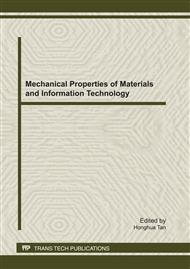[1]
Hui Li, Xinyang Xu Peijun Li, Yin Weil and V A Verkhozina, Research on ammonibacteria removing organic nitrogen in construction wetland, Journal, Chinese journal of Environmental Engineering, China, vol. 2, pp.1044-1047, August (2008).
Google Scholar
[2]
J.S. Strock, Ammonification, Journal, Encyclopedia of Ecology, USA, vol. 6, pp.162-165, June (2008).
Google Scholar
[3]
Qinghua Zhang, Xi Lin Dai and Yi Li, Identification and phylogenesis of ammonifying bacteria from Pondwater of litopenanus vannam, Journal, Journal of fisheries of china, China, vol. 31, pp.692-698, May (2007).
Google Scholar
[4]
Lin Tang, Jinping Zhang and Gang Zhu, Study on distributing, physiological and bio-chemical analysis on ammonifiers in Suzhou creek, Journal, Environmental Monitoring in China, China, vol. 22, pp.89-91, June (2006).
Google Scholar
[5]
Shinya Hotta and Naoyuki Funamizu, Evolution of ammonification of potential in storage process of urine with fecal contamination, Journal, Bioresource Technology, Japan, vol. 99, pp.13-17, January (2008).
DOI: 10.1016/j.biortech.2006.12.001
Google Scholar
[6]
Songlin Wang, Xiaohui Wu and Yansong Wang, Removal of organic matter and ammonia nitrogen from landfill leachate by ultrasound, Journal, Ultrasonics Sonochemistry. Korea, vol. 43, pp.933-937, April (2008).
DOI: 10.1016/j.ultsonch.2008.04.006
Google Scholar
[7]
Hong-Duck Ryu, Daekeun Kim and Heun-Eun Lim. Nitrogen, Nitrogen removal from low carbon-to-nitrogen wastewater in four-stage biological aerated filter system, Journal, Process Biochemistry, China, vol. 40, pp.729-735, December (2008).
DOI: 10.1016/j.procbio.2008.02.018
Google Scholar
[8]
Jin Li, Fenghua Xu and Huting Wang, Anaerobic filter and the protein ammonifiers acid solution pH, Journal, Journal of northeast agricultural university, China, vol. 40, pp.45-49, June (2009).
Google Scholar
[9]
Xiuzhu Dong, Identification Manual of Common Bacterial Systems, Science Press, Beijing, (2001).
Google Scholar
[10]
State Environmental Protection Administration editorial, Water and Wastewater Monitoring Analysis Method, China Environmental Science Press, Beijing, (2002).
Google Scholar
[11]
Hongyu Wang, Fang Ma, and Junfeng Su, Identification and characterization of a bacterial strain C3 capable of aerobic denitrification, Journal, Environmental Science, China, vol. 28, pp.1549-1552, July (2007).
Google Scholar
[12]
Qunying Zhou and Yanyao Gao, Environmental Microbiology, Higher Education Press, Beijing, (2006).
Google Scholar


